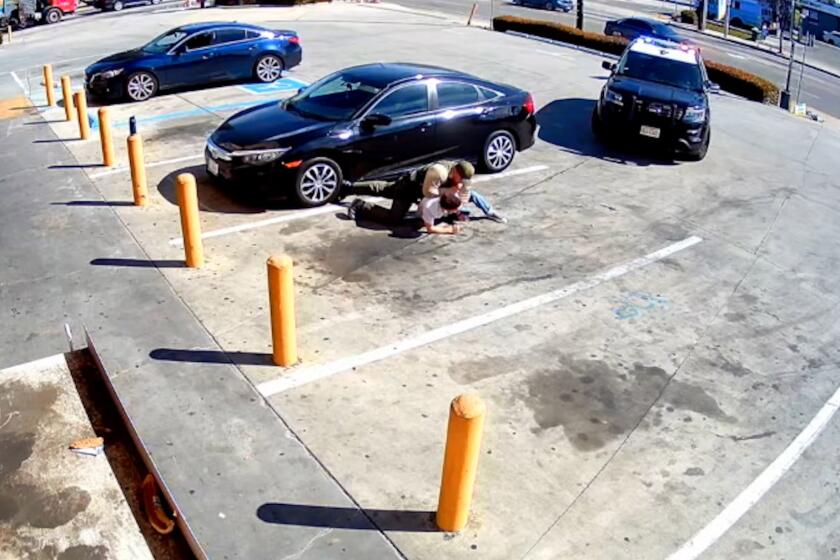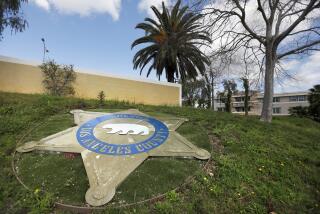Oversight officials concerned about Nazi symbolism in newly discovered deputy subgroup’s logo

- Share via
The Civilian Oversight Commission is raising concerns about a previously unknown deputy subgroup that oversight officials say uses a logo featuring Nazi-like imagery, according to a memo obtained by The Times.
The newly reported group, which is not named in the memo, is based out of the Los Angeles County Sheriff’s Department’s Norwalk station, which had not previously been linked to any reported deputy gang or clique. The unnamed group’s symbol — described in the memo and confirmed to The Times by five sources in the department — is a skull with blood-red eyes, pierced by a jagged lightning bolt.
Longtime commission member Sean Kennedy, who wrote the memo, described the group as “currently active” and said it has sometimes been at odds with another Norwalk subgroup that predates it and is identified by a Wile E. Coyote logo.
Several department sources — who asked to remain anonymous for fear of retaliation — told The Times the newer subgroup dates to at least the 1990s. One department source said the subgroup has a “shot caller” who makes decisions, much like in a prison gang.
Though some deputies in the past have described their ink as merely a “station tattoo” and not the sign of membership in an exclusionary, violent subgroup, Kennedy’s memo dismissed that possibility. It noted that the skull design “cannot be fairly characterized as a ‘station logo’” as its imagery holds little in common with the Norwalk station logo.
L.A. Sheriff’s Department announces policy it says will ban deputy gangs, hate groups
“This certainly would not be the first LASD deputy subgroup that has associated under a symbol with neo-Nazi or white supremacist connotations,” Kennedy wrote. “The logo of a skull with blood-red eye sockets and lightning bolts does not inspire confidence that the subgroup values de-escalation and constitutional policing.”
For half a century, the department has been plagued by allegations about tattooed groups of deputies who run roughshod over certain sheriff’s stations and promote a culture of violence. The rogue groups are commonly known by names such as the Executioners, the Banditos, the Regulators and the Little Devils, and their members typically have matching, sequentially numbered tattoos featuring lurid imagery.
In response to a request for comment, the department said it had not been aware of any alleged subgroups at Norwalk until the Civilian Oversight Commission raised the issue. Officials confirmed there is an “ongoing inquiry” into the matter.
The commission’s probe into the group began after a Norwalk deputy was caught on camera beating a transgender man in a 7-Eleven parking lot early last year.
Emmett Brock, then 23, was on the way home from his high school teaching job when Deputy Joseph Benza confronted him outside the store. After beating and arresting Brock, Benza accused the teacher of biting him — potentially elevating the incident to a felony crime.
But prosecutors dropped the case a few months later, and early this year a judge declared Brock innocent. Afterward, Kennedy took interest in the case.
As he investigated the incident and the deputy at the center of it, Kennedy wrote in his memo, he learned about a group of Norwalk deputies using the logo. In addition to the white skull and single lightning bolt, he said the image features a red numeral 4. Founded in 1926, Norwalk was the Sheriff’s Department’s fourth station.
A new report by the Civilian Oversight Commission condemned the “cancer” of violent deputy gangs in the Los Angeles County Sheriff’s Department and urged a ban on the secretive groups.
When he sent the memo to other members of the commission in July, Kennedy laid out his findings but wrote that he hesitated to label the unidentified group as a deputy “gang.” Instead, he said he chose to use the “neutral term ‘subgroup’” because he had “insufficient information to conclude whether the group of deputies at the Norwalk Station associating under this symbol constitute a clique or deputy gang.”
After interviewing more than a dozen current and former deputies, The Times tracked down two versions of the group’s image, one in color and one in black and white.
It’s not clear whether the group’s members sequentially number their tattoos, or whether the group has been linked to any misconduct. Even so, Kennedy’s memo raised concerns about the implications of the image.
“While lightning bolts have different connotations,” Kennedy wrote, “many so-called ‘white power’ groups have adopted single or double lightning bolts as a symbol because they were used by various Nazi groups — such as the Schutzstaffel (SS) and the Hitler Youth — as well as by contemporary neo-Nazi groups, such as National Action.”
A few years ago, a similar symbol sparked concern in Arizona, after an investigation by the Arizona Republic found that the state’s prison system had spent more than $2,600 on patches for guards’ uniforms as well as other memorabilia featuring questionable imagery.
Like the Norwalk group’s image, the patch featured a red-eyed skull pierced by a lightning bolt, along with two shotguns and a “Special Operations & Tactics” label. At the time, former California prison administrator Mike Brady told the Republic that the patch bore a resemblance to some elements common to prison gang imagery.
“Lightning bolts are connected with the Aryan Brotherhood. You’ve got a skull and shotguns — frankly, it’s disturbing and offensive,” he said. “It looks like an SS patch. This is not an image that Corrections should embrace.”
The Arizona corrections department ultimately suspended use of the patch, which it said was not intended to evoke associations with “white supremacists, Nazis, or any other hateful group.”
More than a year after he was accused of biting a deputy who beat him in a 7-Eleven parking lot in Whittier, a court declared Emmett Brock factually innocent.
The emergence of the Norwalk image is not the first time an L.A. County Sheriff’s Department deputy subgroup or gang has been associated with white supremacist groups or their imagery.
Three decades ago, a federal judge described one deputy group — the Lynwood Vikings — as a “neo-Nazi, white supremacist gang” using “terrorist-type tactics” to routinely violate people’s civil rights. And for years, the notorious Compton Station subgroup known as the Executioners has reportedly used a logo featuring a gun-toting skeleton wearing a Nazi-style helmet
That same year, a former Sheriff’s Department captain told Spectrum News about a Carson station subgroup tattoo featuring a skull, a gravestone and an Iron Cross — an image commonly associated with white supremacists.
Both Kennedy and Hans Johnson, another member of the Civilian Oversight Commission, raised concerns about how a tattooed subgroup in Norwalk could have influenced the station culture and given rise to the sort of violence caught on camera during Brock’s arrest last year.
“Gang behavior,” Johnson said, “deteriorates standards and invites brash and violent mistreatment of civilians.” Though the Brock case and the deputy at the center of it may have no “narrow connection to deputy gangs,” Johnson said the incident “raises questions about the spillover behavior of deputy gangs on the rest of the station.”
News of the Norwalk subgroup comes as the Sheriff’s Department renews its efforts to crack down on exclusionary groups within its ranks. Last month, Sheriff Robert Luna announced a new and controversial policy formally banning the groups and requiring deputies to cooperate with investigations into them.
Though the policy was two years in the making, it quickly came under fire. Former Sheriff Alex Villanueva said it was “nothing more than a rehash” of his prior policy and predicted it would fail any legal challenges in court.
Community groups questioned whether the policy would actually help eradicate the groups. And oversight officials faulted it for failing to ban deputy cliques — the term oversight officials and researchers use to describe exclusionary subgroups not known to engage in egregious misconduct.
“The history of the LASD makes clear that these deputy cliques evolve into groups of deputies with pernicious ‘we-they’ attitudes that promote insubordination, foster the use of excessive and unnecessary force, cost county taxpayers millions, and destroy public trust in the Sheriff’s Department,” Robert Bonner, who chairs the oversight commission, told The Times in an email.
“To eradicate this deeply embedded deputy clique culture requires a clear policy banning them,” he said, “and a clear message from the Sheriff that they will no longer be tolerated.”
More to Read
Sign up for Essential California
The most important California stories and recommendations in your inbox every morning.
You may occasionally receive promotional content from the Los Angeles Times.

















